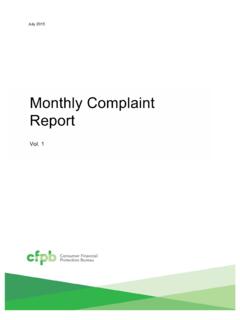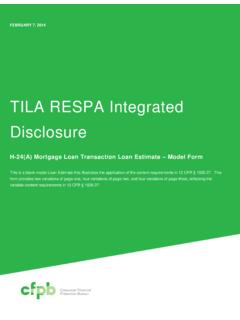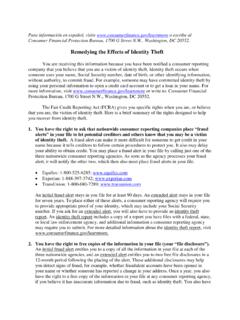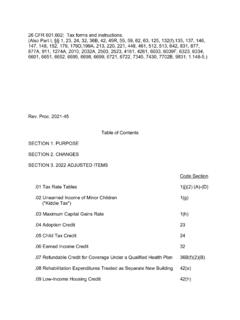Transcription of 2019 Mortgage Market Activity and Trends
1 CONSUMER FINANCIAL PROTECTION BUREAU | JUNE 2020. Data Point: 2019. Mortgage Market Activity and Trends A First Look at the 2019 HMDA Data 1. This is another in an occasional series of publications from the Consumer Financial Protection Bureau's Office of Research. These publications are intended to further the Bureau's objective of providing an evidence-based perspective on consumer financial markets, consumer behavior, and regulations to inform the public discourse. See 12 5493(d).[1]. [1] This report was prepared by Young Jo, Feng Liu, Akaki Skhirtladze, and Laura Barriere. 2 DATA POINT: 2019 Mortgage Market Activity AND TREND.
2 Table of contents Table of 1. Introduction ..4. 2. HMDA data coverage of the Mortgage Market ..8. 3. Mortgage applications and originations ..11. 4. Mortgage outcomes by demographic Distribution of home loans across demographic groups .. 19. Average loan size by demographic group .. 27. Jumbo 31. Variation across demographic groups in nonconventional loan use .. 32. Denial rates and reasons .. 36. 5. Incidence of higher-priced lending ..46. HOEPA loans .. 55. 6. Lending institutions ..58. 7. Conclusion ..69. 3 DATA POINT: 2019 Mortgage Market Activity AND TREND. 1. Introduction This Data Point article provides a first overview of residential Mortgage lending in 2019 based on data collected under the Home Mortgage Disclosure Act (HMDA).
3 HMDA is a data collection, reporting, and disclosure statute enacted in 1975. HMDA data are used to assist in determining whether financial institutions are serving the housing credit needs of their local communities;. facilitate public entities' distribution of funds to local communities to attract private investment;. and help identify possible discriminatory lending patterns and enforce antidiscrimination Institutions covered by HMDA are required to collect and report specified information about each Mortgage application acted upon and Mortgage The data include the disposition of each application for Mortgage credit; the type, purpose, and characteristics of each home Mortgage application or purchased loan ; the census-tract designations of the properties; loan pricing information; demographic and other information about loan applicants, such as their race, ethnicity, sex, age, and income.
4 And information about loan The 2019 HMDA data are the second year of data that incorporate changes made to HMDA. under the Dodd-Frank Wall Street Reform and Consumer Protection Act of 2010 (DFA). Among the changes mandated by the DFA were changes to some data points and also authorizing the Bureau to collect new and revised data points. The Bureau issued a final rule implementing these and other changes in October 2015 (2015 HMDA rule).4 The 2015 HMDA rule made four primary changes to the data collected starting in January 1, 2018: (1) mandated reporting of open-end lines of credit (LOCs); (2) changed the transactional coverage definition from loan - purpose-based to one based primarily on whether the loan was secured by a dwelling; (3).
5 Modified definitions and values of some existing data points; and (4) required reporting of 27. new data 1 For a brief history of HMDA, see Federal Financial Institutions Examination Council, History of HMDA, available at 2 The 2019 HMDA data, which are used for the analysis of this Data Point, cover Mortgage applications acted upon and mortgages purchased during the calendar year of 2019 and reported in 2020. 3 See for a full list of items reported under HMDA for 2019. 4 See Home Mortgage Disclosure (Regulation C), 80 FR 66128 (Oct. 28, 2015). In September 2017, the Bureau published in the Federal Register a rule which made a few technical corrections to and clarified certain requirements of the rule implementing HMDA.
6 This rule also increased the threshold for collecting and reporting data about open-end LOCs for a period of two years. See 82 FR 43088 (Sep. 13, 2017). 5 beginning with 2018 HMDA data, the Economic Growth, Regulatory Relief, and Consumer Protection Act (EGRRCPA) exempted certain insured depository institutions and credit unions from the requirement 4 DATA POINT: 2019 Mortgage Market Activity AND TREND. Consistent with the last year, the Consumer Financial Protection Bureau (hereafter, Bureau) is issuing two Data Point articles. This first article follows a consistent format as previous annual articles released by the Federal Reserve, which accompanied the release of a public version of the aggregate HMDA data, and focuses specifically on Trends in Mortgage applications and originations.
7 By examining the HMDA data over several years (2004 2019), this article closely analyzes Trends using historical data points that had been collected prior to the 2015 HMDA. Rule. The Bureau's second Data Point article, which is scheduled to be published later, includes analyses of open-end LOCs and dwelling-secured applications not covered in the first article. Furthermore, the second article focuses on an in-depth cross-sectional analysis of new or revised data points that were added under the 2015 HMDA rule. The Bureau is releasing these two articles at different times to make the static application-level 2019 HMDA data file available to the public as soon as possible.
8 With the first Data Point article, the Bureau is publishing a static application-level 2019 HMDA. data file that consolidates data from individual reporters. The data file is modified to protect applicant and borrower The data file and the two Data Point articles reflect the data as of April 27, 2020. Though this static file will not change, the Bureau will also provide an updated file separately to reflect any later resubmissions or late submissions. The results using the updated file may differ from those reported in this Data Point article, although the Bureau expects them to be largely consistent.
9 The remainder of this article summarizes the 2019 HMDA data and recent Trends in Mortgage applications and originations. The Bureau seeks to make the 2019 HMDA data as comparable as possible to HMDA data from previous years, including HMDA data prior to the data collected in 2018 when the majority of the 2015 HMDA Rule took effect. To do this, the Bureau excludes million open-end LOCs except reverse mortgages and the million records that were dwelling- secured but for a purpose other than purchase, home improvement, or refinance, because such records were not required to be reported prior to 2018.
10 In addition, the Bureau converts any to collect and report data on 26 of the 27 new data points added under the 2015 HMDA rule for certain types of entities and transactions. For more details on the 2015 HMDA rule, see the Data Point: 2018. Mortgage Market Activity and Trends , available at research/research-reports/data-point-201 8- Mortgage - Market - Activity -and- Trends /. 6 For more information concerning these modifications and the Bureau's analyses under the balancing test it adopted to protect applicant and borrower privacy while also fulfilling HMDA's disclosure purposes, see 84 FR 649 (January 1, 2019).













